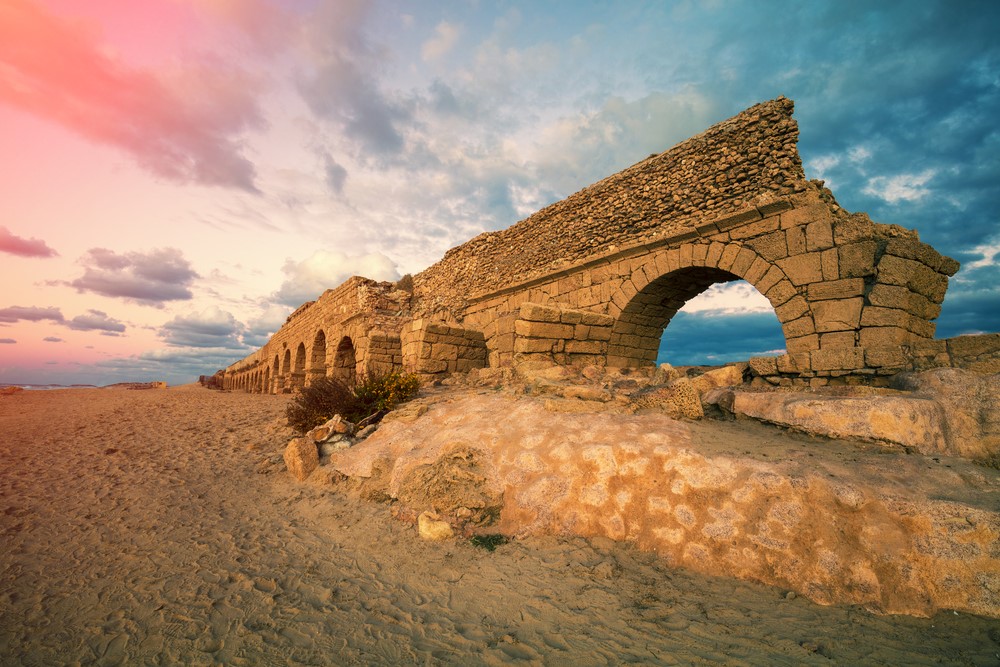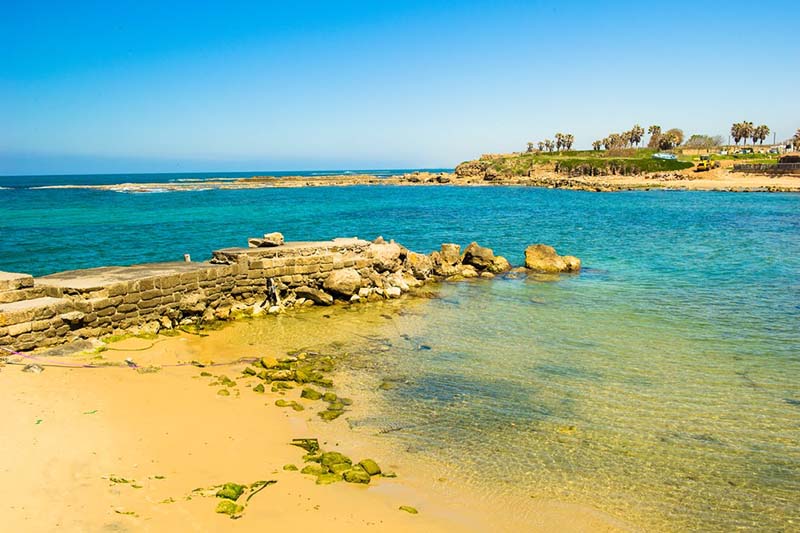Herod’s Vision for Caesarea Maritima
Herod the Great had a vision. A port twice the size of Athen’s – with mighty and massive seawalls rising out of the deep Mediterranean water on the coast of Judea. He would reshape not only the land – but the sea itself. The vision was backed with the might and purse of Caesar Augustus – the laws of reality never had a chance. Creating a harbour out of a series of reefs. He would carve a new city into the local sandstone called Kurkar.
While easily worked, Kurkar is dense in calcite which creates a natural bonding agent cementing the grains tightly and resiliently. With it, he would create his deep water harbour, his amphitheatre, his hippodrome and his aqueduct. He would name it Caesarea Maritima after his patron Caesar Augustus.

Aqueduct at Caesarea Maritima (source: Deposit Photos)

Seawalls still standing at Caesarea Maritima source: DepositPhotos
The Technological Marvel of Seawalls
Then as now, technology enabled the realization of the impossible. Hydraulic cement, pioneered by Rome’s Royal Engineers (which cured when submerged in water) allowed the sea walls to rise from the depth of the azure sea to form stone and concrete seawalls that would control flooding, protect the shoreline and provide safe anchorage for up to 300 ships. The city could not have been built without hydraulic cement – it is the literal foundation on which it stands. Herod’s city became an important mercantile hub in Judea. In time it would be famous for more than its sea walls.
A Sacred Location: Caesarea Maritima and the Apostles
You’ve probably read about Caesarea without knowing its history – particularly if you grew up attending church. Some fifty years after engineers began their work, history records that the Apostle Peter converted a Centurion named Cornelius there. Remember that story? Phillip evangelized in its streets and the Apostle Paul probably looked out on the harbour while imprisoned there for two years prior to his trial in Rome. Astonishingly, 2000 years later the hydraulic cement seawalls of the Royal Engineers, (and the work of the Apostles), still stands.
The Investment Seawall: The Role of Gold
Seawalls provide protection for the investments of maritimers. Wherever there is commerce, the protection of investments is key. Some things never change. For investors, gold has maintained its role as a store of value for longer than the seawalls at Caesarea Maritima have stood. Out of favour for some time, gold is staging a comeback as the chart below shows.

source: Stockcharts.com
Gold Miners: Waiting for the Catch-Up
Curiously, gold miners have not yet joined the party as the next chart shows. This setup is called a “non-confirmation”. Simply put, investors who are bullish on gold will expect the miners to “catch-up” to gold. Those who are bearish, expect that gold will reverse.

source: YCharts.com
Gold’s Seawall Role During Inflation
Gold has disappointed during this storm of high inflation – failing to provide the usual “seawall” to investors. Or has it? If we accept the premise that gold is designed to protect against high inflation and currency debasement, let’s price it in Turkish Lira and Japanese Yen for comparison.


Curious about the price of Gold in Canadian dollars? Take a peek:

Gold’s Continued Value in Inflationary Times
Do you see what I see? Gold still acts like a seawall against the waves of high inflation and currency devaluation. Turkish and Japanese investors have found protection with it. The winds are blowing stronger in Canada as well. Gold may be set to resume its traditional role of providing a safe harbour for investors. Herod would approve!
